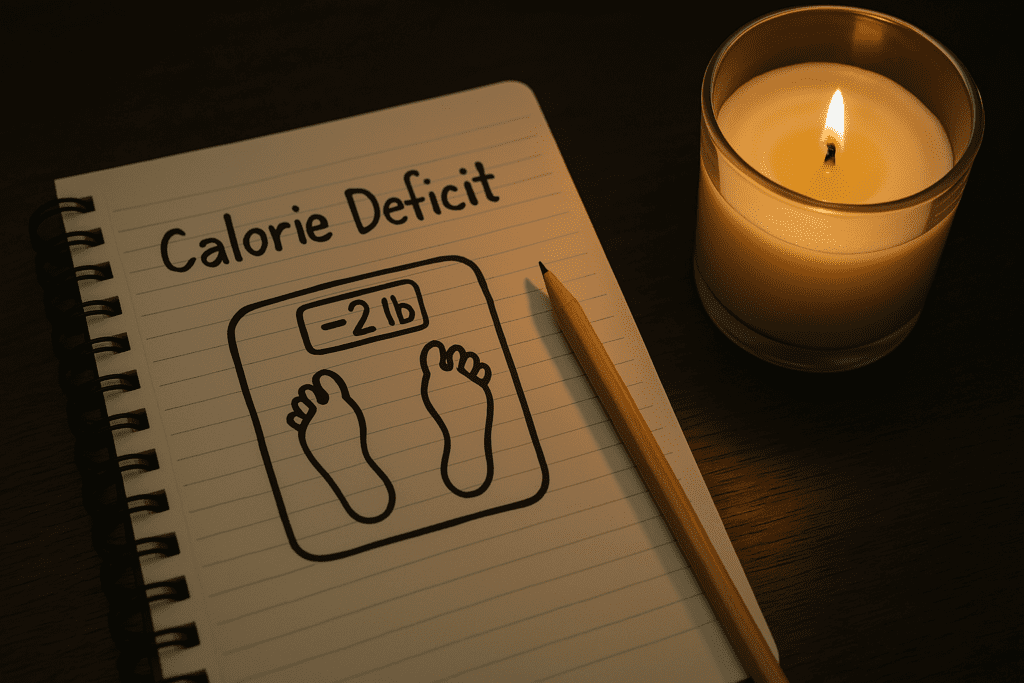Achieving sustainable weight loss requires an understanding of how calorie balance works in the body. Specifically, creating a calorie deficit is a key component of any weight loss plan. For many, the goal of losing two pounds a week is a reasonable and healthy target. However, to reach this goal safely, it is essential to understand how to calculate a calorie deficit, how to figure out the exact amount of calories to cut, and what strategies to adopt to ensure this weight loss is both effective and sustainable.
You may also like: Expert-Backed Weight Loss Tips for a Healthier Lifestyle: What You Need to Know for Long-Term Weight Control and Wellness
In this article, we will explore the science behind calorie deficits, delve into expert advice on how to lose two pounds a week, and guide you through the calculation process with step-by-step methods. Whether you’re aiming to lose 2 pounds in a week or aiming for a longer-term weight loss plan, the tips provided here will ensure that you approach weight loss with health and wellness at the forefront.
Understanding the Concept of a Calorie Deficit
A calorie deficit occurs when the body burns more calories than it consumes. For weight loss to happen, the body needs to be in a state where it is expending more energy than what is provided through food and drink. This forces the body to tap into its fat stores for energy, leading to weight loss over time.
To lose two pounds in a week, it’s important to understand how much of a deficit is needed. Research suggests that approximately 3,500 calories equals one pound of body fat. Therefore, to lose two pounds, you would need a total deficit of 7,000 calories over the course of a week. This translates to a daily deficit of about 1,000 calories.
While it might sound like a lot, achieving this deficit is possible through a combination of dietary changes and increased physical activity. The key is balancing these factors without compromising nutritional intake or overall health.

How to Calculate Calorie Deficit to Lose 2 Pounds a Week
The process of calculating your calorie deficit starts with understanding your Total Daily Energy Expenditure (TDEE). Your TDEE is the total number of calories your body needs to perform daily activities, including exercise, digestion, and basic bodily functions like breathing and heartbeat. To calculate your TDEE, you can use the following formula:
- Find your Basal Metabolic Rate (BMR): This is the number of calories your body burns at rest, without any activity. Various online calculators can help estimate your BMR, but a common method to calculate it is the Harris-Benedict Equation:
For women:
BMR=655+(9.6×weight in kg)+(1.8×height in cm)−(4.7×age)BMR = 655 + (9.6 \times \text{{weight in kg}}) + (1.8 \times \text{{height in cm}}) – (4.7 \times \text{{age}})
For men:
BMR=66+(13.7×weight in kg)+(5×height in cm)−(6.8×age)BMR = 66 + (13.7 \times \text{{weight in kg}}) + (5 \times \text{{height in cm}}) – (6.8 \times \text{{age}}) - Factor in activity level: After calculating your BMR, you must multiply it by an activity factor based on your lifestyle:
- Sedentary (little to no exercise): BMR × 1.2
- Lightly active (light exercise/sports 1-3 days/week): BMR × 1.375
- Moderately active (moderate exercise/sports 3-5 days/week): BMR × 1.55
- Very active (hard exercise/sports 6-7 days a week): BMR × 1.725
- Super active (very hard exercise & physical job or training twice a day): BMR × 1.9
- Sedentary (little to no exercise): BMR × 1.2
- Calculate your calorie deficit: Once you know your TDEE, subtract the required number of calories to create a deficit. For instance, to lose two pounds a week, you need to create a daily deficit of about 1,000 calories. If your TDEE is 2,500 calories, you should aim to consume around 1,500 calories per day.
Adjusting Your Diet to Achieve a Calorie Deficit
While creating a calorie deficit is necessary, it’s just as important to ensure that you are still meeting your nutritional needs. Focusing on whole, nutrient-dense foods can help you maintain energy levels and overall health as you lose weight. Here’s how to adjust your diet:
- Prioritize lean proteins: Protein helps with muscle preservation during weight loss and keeps you feeling full longer. Foods like chicken, fish, tofu, and legumes are excellent sources of lean protein.
- Incorporate healthy fats: While cutting calories, it’s crucial not to eliminate fats entirely. Healthy fats from sources such as avocados, nuts, and olive oil provide satiety and support overall health.
- Increase fiber intake: Fiber-rich foods such as fruits, vegetables, and whole grains help you feel fuller and provide essential vitamins and minerals.
- Avoid processed foods: Processed and high-sugar foods can be tempting, but they contribute to calorie excess without providing much nutritional value. Instead, focus on whole foods like vegetables, fruits, and whole grains.
- Track your calories: To ensure you’re staying within your calorie deficit target, tracking your food intake using an app or food diary can be helpful. This allows you to monitor portion sizes and make adjustments as needed.
How Exercise Contributes to Your Calorie Deficit
In addition to adjusting your diet, exercise plays a significant role in creating a calorie deficit. Exercise increases the number of calories your body burns and helps you achieve a higher energy expenditure. Here’s how different types of exercise can contribute:
- Cardiovascular exercise: Activities like running, cycling, and swimming increase your heart rate and burn significant calories. A 30-minute session of moderate-intensity cardio can burn between 200-400 calories depending on factors such as intensity and body weight.
- Strength training: Building muscle through strength training not only boosts your metabolism but also helps preserve lean muscle mass while you lose fat. Stronger muscles burn more calories at rest, making strength training an essential part of any weight loss program.
- High-intensity interval training (HIIT): HIIT involves short bursts of intense exercise followed by brief rest periods. This type of training is proven to burn a significant number of calories in a short amount of time and boosts metabolism even after the workout is finished.
- Non-exercise activity thermogenesis (NEAT): NEAT refers to the calories burned through non-exercise movements such as walking, standing, and even fidgeting. Increasing NEAT throughout the day by taking the stairs, walking more, or standing at your desk can make a big difference in creating a calorie deficit.
How to Lose 2 Pounds a Week Safely
While it is possible to lose two pounds a week, it’s important to do so safely. Losing weight too quickly can lead to muscle loss, nutritional deficiencies, and other health complications. Here are a few tips for losing weight safely and sustainably:
- Avoid extreme calorie restrictions: Drastically reducing your calorie intake may result in rapid weight loss, but it can also cause your metabolism to slow down, making long-term weight management more difficult.
- Stay hydrated: Drinking plenty of water is essential when losing weight. Not only does it support metabolism, but it also helps with satiety, reducing the temptation to overeat.
- Get enough sleep: Sleep is crucial for weight loss. Studies show that insufficient sleep can disrupt hormonal balance, increasing hunger and cravings for unhealthy foods.
- Be patient: Weight loss is a gradual process. While aiming to lose two pounds a week is achievable for many people, it’s important to remember that results may vary depending on individual factors like age, gender, and genetics.
Is Losing 2 Pounds a Week Healthy?
The short answer is yes—losing two pounds a week is generally considered healthy for most people. It falls within the recommended range of 1-2 pounds of weight loss per week, which is considered both safe and sustainable by health professionals.
However, it’s essential to tailor your weight loss goals to your individual circumstances. Factors such as current weight, overall health, and lifestyle play a significant role in determining the right pace for you. Always consult with a healthcare provider before starting any new weight loss plan, especially if you have underlying health conditions.

Frequently Asked Questions (FAQ)
1. What is a calorie deficit, and how does it relate to losing 2 pounds a week?
A calorie deficit occurs when you consume fewer calories than your body needs to maintain its current weight. To lose 2 pounds a week, you need to create a calorie deficit of approximately 7,000 calories per week, as 1 pound of fat is roughly equivalent to 3,500 calories. This means that to lose 2 pounds in a week, you would need to achieve a daily calorie deficit of 1,000 calories. Achieving this deficit can be done through a combination of eating fewer calories and increasing physical activity. While a calorie deficit for weight loss is essential, it’s crucial to ensure that you’re still providing your body with sufficient nutrients to maintain overall health.
2. How can I calculate my calorie deficit to lose 2 pounds a week?
To calculate a calorie deficit, start by determining your Total Daily Energy Expenditure (TDEE), which is the total number of calories your body needs each day to perform basic functions and physical activities. Once you know your TDEE, subtract 1,000 calories from it to achieve the necessary daily deficit for losing 2 pounds a week. For example, if your TDEE is 2,500 calories, you would aim to consume around 1,500 calories per day to create the required calorie deficit. Remember that calculating caloric deficit requires accuracy, so tracking your food intake and physical activity is crucial to ensure you’re hitting your target.
3. Can I lose 2 pounds a week by only cutting calories?
While cutting calories is an essential part of creating a calorie deficit to lose 2 pounds a week, it’s not the only factor at play. A combination of a reduced-calorie diet and increased physical activity is the most effective way to lose weight in a sustainable manner. Exercise, especially cardio and strength training, can increase the number of calories your body burns, which helps you create a larger calorie deficit. Additionally, exercise helps preserve muscle mass, which is vital for maintaining metabolic rate as you lose weight. A balanced approach is key to successful, healthy weight loss.
4. How can I find my exact calorie deficit for weight loss?
To find your exact calorie deficit, you must first calculate your TDEE and determine how many calories you need to cut based on your weight loss goals. For example, if your aim is to lose 2 pounds a week, you need a daily deficit of 1,000 calories. You can use online tools or apps to help you calculate your TDEE and determine how to figure out calorie deficit accurately. Regular tracking of your food intake and exercise will help you stay on track and make adjustments if necessary. It’s important to remember that these calculations are estimates, and the exact calorie deficit for weight loss can vary depending on factors like age, gender, and body composition.
5. Is losing 2 pounds a week healthy?
Yes, losing 2 pounds a week is generally considered a safe and sustainable rate of weight loss. Health experts typically recommend losing 1-2 pounds per week, as this allows for steady weight loss without negatively impacting metabolism, muscle mass, or overall health. Rapid weight loss can sometimes lead to nutrient deficiencies and other health complications. However, it’s important to approach weight loss with a balanced mindset, focusing on a healthy diet, exercise, and overall well-being. If you’re aiming to lose 2 lbs a week, it’s essential to ensure that your calorie deficit is moderate and that you’re meeting your nutritional needs.
6. How can I lose 2 pounds a week without losing muscle mass?
To lose 2 pounds a week without losing muscle mass, it’s important to focus on a well-rounded approach that includes both a calorie deficit and muscle-preserving strategies. Strength training exercises, such as weightlifting, can help you maintain or even build muscle mass while losing fat. Additionally, consuming an adequate amount of protein is essential for muscle preservation. Aim for protein-rich foods like lean meats, legumes, and dairy, and make sure you’re consuming enough calories to support muscle repair and growth. Lastly, avoid drastic calorie cuts, as very low-calorie diets can lead to muscle loss.
7. How can I figure out my calorie deficit for women specifically?
For women, calculating a calorie deficit is similar to the process for men, but there are some gender-specific factors to consider. Women tend to have a lower muscle mass than men, which can result in a lower Basal Metabolic Rate (BMR). This means that women may need to be more cautious with their calorie reduction to avoid slow metabolism or nutrient deficiencies. Start by calculating your BMR using a reliable formula and multiply it by your activity level to find your TDEE. From there, subtract 500-1,000 calories to create a calorie deficit for weight loss. Women should also prioritize nutrient-dense foods to support overall health while in a calorie deficit.
8. How can I lose 2 pounds a week safely without resorting to extreme dieting?
To lose 2 pounds a week safely, avoid extreme calorie cutting, and instead focus on creating a moderate calorie deficit combined with regular exercise. Sustainable weight loss is best achieved by gradually reducing calorie intake while maintaining adequate nutrition. This can be done by focusing on whole foods like vegetables, fruits, lean proteins, and whole grains, which will help you feel fuller longer and provide essential vitamins and minerals. Additionally, incorporating regular physical activity, such as daily walking, cardio, and strength training, will increase your calorie burn. Consistency, patience, and a balanced approach to nutrition and exercise are key to losing weight in a healthy manner.
9. Can I lose 2 pounds in 4 days?
Losing 2 pounds in 4 days is technically possible, but it’s not recommended as a long-term weight loss strategy. Rapid weight loss is usually due to water loss, not fat loss, and can be harmful to your health. To achieve sustainable weight loss, it’s best to aim for 1-2 pounds per week, as this rate of loss allows your body to adjust and ensures you’re losing fat, not muscle. If you’re looking to lose weight quickly, it’s essential to focus on healthy habits, such as reducing your calorie intake moderately and increasing your activity levels, rather than relying on drastic, short-term measures.
10. How do I stay motivated to lose 2 pounds a week?
Staying motivated to lose 2 pounds a week can be challenging, but setting realistic goals and tracking your progress can help keep you on track. Focus on both the short-term and long-term benefits of weight loss, such as improved health, better energy levels, and increased confidence. Surround yourself with supportive individuals, whether through friends, family, or online communities, to share your successes and challenges. Additionally, make the process enjoyable by experimenting with new, healthy recipes or finding an exercise routine you love. Consistency is key—by focusing on gradual, sustainable changes, you can achieve your weight loss goals without feeling overwhelmed.

Final Thoughts on Achieving a Calorie Deficit for Weight Loss
In conclusion, creating a calorie deficit is key to losing weight, and calculating the right deficit to lose 2 pounds a week requires a combination of proper nutrition, exercise, and consistency. By calculating your TDEE, adjusting your diet, increasing your physical activity, and staying patient, you can achieve your weight loss goals safely and sustainably. Keep in mind that healthy weight loss is about making long-term lifestyle changes that support your overall well-being, not just temporary fixes.
For many individuals, creating a calorie deficit for weight loss—especially through the simple strategy of reducing calories by 500 to 1,000 a day—will result in steady, healthy weight loss. If you aim for a consistent, gradual approach, you’ll see results that last.
healthy weight loss tips, creating a calorie deficit, sustainable weight loss, effective weight loss strategies, fat burning tips, losing weight through exercise, healthy diet plans, maintaining muscle mass while losing weight, daily calorie goals, tracking calorie intake, calorie burning activities, balanced weight loss, mindful eating, weight loss and metabolism, overcoming weight loss plateaus, setting realistic weight loss goals, exercise for fat loss, fitness for weight loss, nutrition for weight loss, weight loss motivation, long-term weight management
Further Reading:
What should you know about a safe and effective caloric deficit for weight loss?
How to Calculate Calorie Deficit for Weight Loss
How to lose 2 pounds a week through diet and lifestyle changes, according to experts
Disclaimer
The information contained in this article is provided for general informational purposes only and is not intended to serve as medical, legal, or professional advice. While MedNewsPedia strives to present accurate, up-to-date, and reliable content, no warranty or guarantee, expressed or implied, is made regarding the completeness, accuracy, or adequacy of the information provided. Readers are strongly advised to seek the guidance of a qualified healthcare provider or other relevant professionals before acting on any information contained in this article. MedNewsPedia, its authors, editors, and contributors expressly disclaim any liability for any damages, losses, or consequences arising directly or indirectly from the use, interpretation, or reliance on any information presented herein. The views and opinions expressed in this article are those of the author(s) and do not necessarily reflect the official policies or positions of MedNewsPedia.


